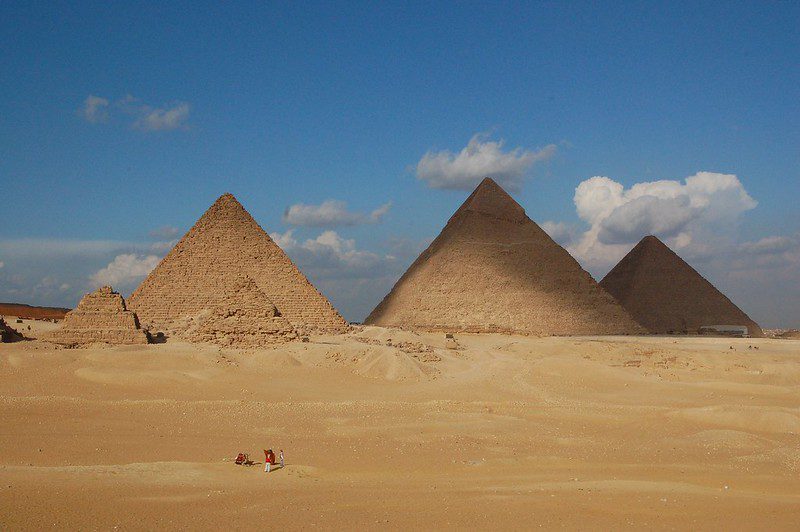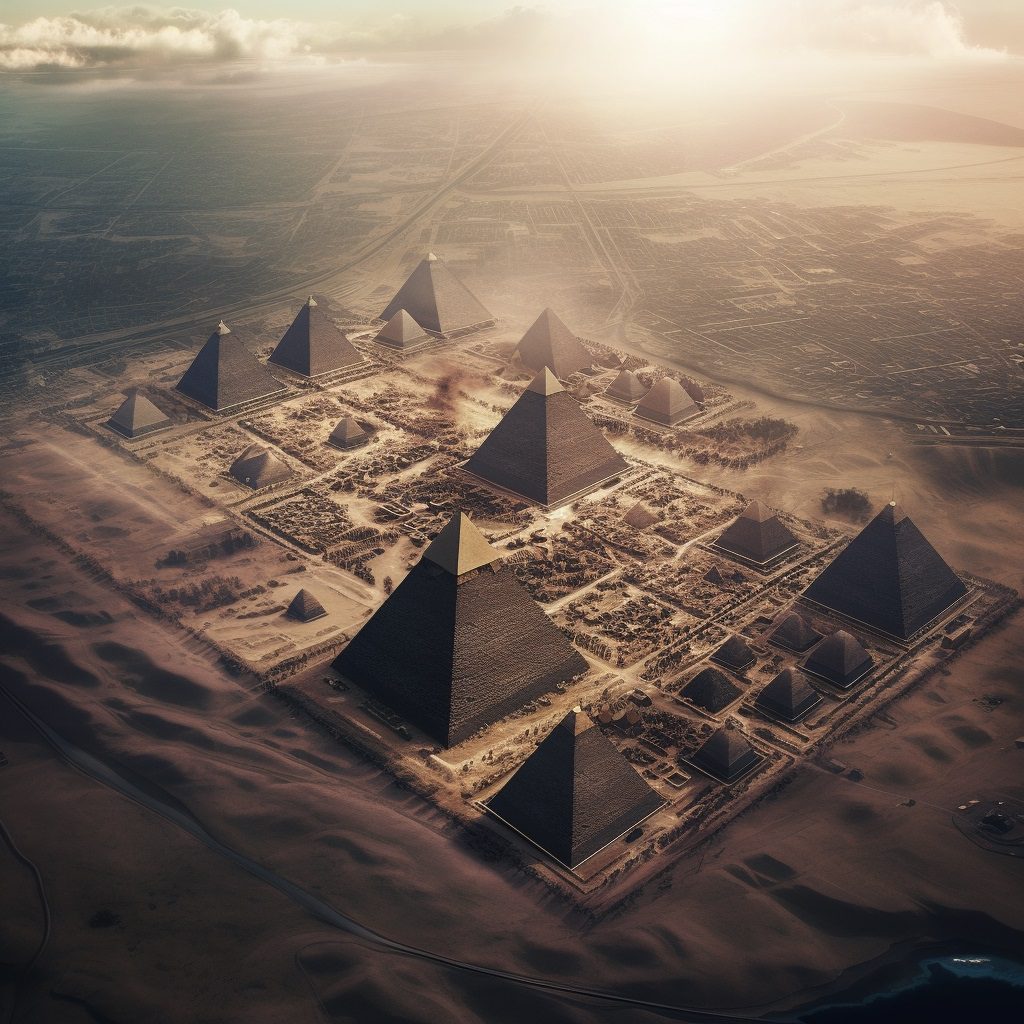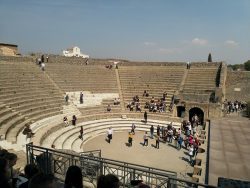
When discussing the marvels of ancient architecture, one cannot overlook the significance of the Ancient Egypt Pyramids. These magnificent structures have captivated historians and nature lovers alike for centuries, leaving us with endless questions about their purpose and construction techniques.
In this blog post, we will delve into the birthplace of pyramid building by examining Djoser’s step pyramid as a starting point for future pyramids and exploring architectural innovations that led to larger, more complex structures. We will also discuss the evolution of pyramids in Ancient Egypt, including their progression from smaller mastabas to grander pyramidal forms.
Moreover, we’ll analyze the Great Pyramid of Khufu in detail – its construction methods and how it relates to celestial bodies. As we explore these fascinating topics related to Ancient Egypt Pyramids, we’ll also touch upon a short-lived era of giant pyramids along with possible reasons behind abandoning large-scale projects and shifts in religious beliefs or political priorities affecting construction choices.
Last but not least, our journey through ancient Egyptian history would be incomplete without delving into discoveries made through modern archaeology. We’ll examine how innovative technology has been used to study pyramid structures and gain insights from excavations in Egypt’s Valley of the Kings.
The Birthplace of Pyramid Building
Behold the birthplace of pyramid building in ancient Egypt, where it all began with Djoser’s six-tiered giant, the first-ever pyramid to grace this magnificent civilization. This architectural revolution aimed at securing the pharaoh’s physical body for eternity and ensuring that the king would be remembered by the living.
Djoser’s Step Pyramid as a Starting Point for Future Pyramids
Inspired by their predecessors’ mastabas, Djoser and his architect Imhotep dared to dream bigger and bolder, creating an awe-inspiring structure that would set a precedent for future generations. The step pyramid was designed as a series of six mastabas stacked on top of one another, each level decreasing in size as they ascended toward the heavens. This innovative design not only captivated those who beheld it but also laid down a blueprint for subsequent pyramids.

Architectural Innovations Leading to Larger, More Complex Structures
The Egyptians were never ones to rest on their laurels; instead, they continued pushing boundaries and experimenting with new techniques throughout history. As time went on, architects refined their skills and honed their craft until they could create structures even more colossal than before:
- Sneferu’s Bent Pyramid: A daring experiment with angles resulted in its unique bent shape due to structural instability issues during construction (source).
- Sneferu’s Red Pyramid: Learning from past mistakes led Sneferu to build a true smooth-sided pyramid, paving the way for future architectural marvels (source).
- The Great Pyramid of Khufu: The culmination of centuries of innovation and expertise resulted in this iconic monument that still stands today as a testament to human ingenuity (source).
Desiring immortality and reverence, these ancient Egyptians constructed some of the most remarkable edifices ever seen. Their passion for architecture not only led them to create colossal monuments but also inspired generations that followed.
Key Takeaway:
The birthplace of pyramid building in ancient Egypt began with Djoser’s six-tiered giant, the first-ever pyramid that aimed at securing the pharaoh’s physical body for eternity. The step pyramid was designed as a series of six mastabas stacked on top of one another, each level decreasing in size as they ascended toward the heavens and laid down a blueprint for subsequent pyramids.
Evolution of Pyramids in Ancient Egypt
The journey from humble beginnings to the colossal structures we know today is a tale of architectural prowess and human ambition. Over less than 500 years, Egyptian kings developed and refined their approach to constructing massive pyramids like those found on Giza’s west bank. These monumental stone structures served not only as tombs but also as symbols of power and eternal life.
Progression from Smaller Mastabas to Grander Pyramidal Forms
In the early days, ancient Egyptians buried their dead in simple mud-brick structures called mastabas. However, with time came innovation – enterprising architects dared to dream bigger. The transformation began when they started stacking mastabas atop one another, creating a step-like structure that eventually evolved into the first pyramid – Djoser’s Step Pyramid at Saqqara. From thereon out, it was an unstoppable race towards grandiosity.
Experimentation with Angles and Materials Throughout History
Egyptian builders were relentless in their pursuit of perfection. They experimented tirelessly with different angles for their pyramids’ slopes until they discovered the golden ratio that would give them both stability and awe-inspiring height: approximately 52 degrees. This revelation led them to construct some truly astonishing monuments, such as the Great Pyramid of Khufu (Cheops), which stands tall even today.
- Bent Pyramid: A daring experiment by Pharaoh Sneferu resulted in this peculiarly shaped monument whose slope changes midway up its sides due to structural instability during construction.
- Red Pyramid: Sneferu’s second attempt at a smooth-sided pyramid, the Red Pyramid, boasts a more conservative angle of 43 degrees and is considered the first successful true pyramid.
- The Great Pyramids of Giza: The crowning achievements in Egyptian pyramid construction are undoubtedly the three pyramids on Giza’s plateau – Khufu (Cheops), Khafre (Chephren), and Menkaure (Mycerinus) – which stand as eternal testaments to their builders’ ingenuity.

In addition to experimenting with angles, ancient Egyptians also explored various materials for their colossal structures. They began with mud bricks but quickly progressed to using limestone blocks quarried from nearby sites. Later on, they even incorporated granite into their designs for added strength and durability.
The evolution of pyramids in ancient Egypt showcases humanity’s relentless pursuit of greatness. As we continue unraveling this fascinating civilization’s mysteries through modern archaeology, we can only marvel at what our ancestors achieved thousands of years ago.
Key Takeaway:
Ancient Egyptians evolved from building simple mud-brick structures to constructing grand pyramids like those found on Giza’s west bank, which served as tombs and symbols of power. They experimented with different angles and materials for their pyramids until they discovered the golden ratio that would give them stability and awe-inspiring height. This resulted in some truly astonishing monuments, such as the Great Pyramid of Khufu (Cheops).
The Great Pyramid of Khufu
As one of the most iconic monuments worldwide, the Great Pyramid of Khufu stands out among other ancient Egyptian wonders due to its immense size and precision engineering. It is considered a testament to human ingenuity during this time period when monumental stone architecture was still relatively new.
Construction Techniques Used in Building Khufu’s Pyramid
Intriguingly, despite being built over 4,500 years ago, many aspects of the construction techniques used for building the Great Pyramid remain shrouded in mystery. However, recent discoveries have shed some light on how such an enormous structure could be erected without modern technology. For instance, it is believed that Egyptians employed a system of ramps and levers to transport massive limestone blocks from quarries located nearby.
- Ramps: A combination of straight and zigzagging ramps might have been utilized to move these colossal stones up each level as they were laid into place.
- Leverage: Levers made from wooden beams would help workers maneuver heavy blocks with ease by reducing their effective weight.
- Precision Alignment: The pyramid’s corners were aligned using astronomical observations or perhaps even simple tools like plumb bobs and water levels.
Significance Behind Its Alignment with Celestial Bodies
Beyond its architectural marvels lies another layer of fascination: the alignment between the Great Pyramid and celestial bodies. The pyramid’s four sides are oriented almost precisely along cardinal directions (north-south-east-west), which suggests an intentional connection with stars or planets visible in the night sky.
Some theories propose that this alignment was intended to facilitate the pharaoh’s journey into the afterlife, as ancient Egyptians believed their rulers would ascend to join celestial deities upon death. Others argue that it might have served a more practical purpose: using stars like Orion’s Belt for navigation and timekeeping in an era before clocks or compasses.
In any case, these remarkable features of the Great Pyramid of Khufu continue to captivate nature lovers and history enthusiasts alike, serving as powerful reminders of humanity’s enduring fascination with both our natural world and our capacity for ingenuity in shaping it.
Key Takeaway:
The Great Pyramid of Khufu is an iconic monument that stands out due to its size and precision engineering. Its construction techniques, including ramps and levers, remain shrouded in mystery, but recent discoveries have shed some light on how it was built. The pyramid’s alignment with celestial bodies has fascinated people for centuries, with theories proposing practical purposes such as navigation or more spiritual reasons like facilitating the pharaoh’s journey into the afterlife.
Short-lived Era of Giant Pyramids
Despite their awe-inspiring nature, Egyptians constructed these colossal pyramids for only a few centuries within their vast 3,000-year history. Unraveling the mystery behind why they ceased building such magnificent edifices remains an ongoing quest among modern-day archaeologists studying ancient Egypt.
Possible Reasons Behind Abandoning Large-Scale Projects
The decline in pyramid construction may have been influenced by various factors. One possibility is that Egypt’s economy could no longer support the immense cost and labor required to build such monumental structures. Moreover, due to the briefer tenures of pharaohs in later times, there was less chance for them to plan and carry out ambitious projects such as those seen during the golden age of pyramid construction.

- Economic strain: The sheer scale of resources needed for constructing giant pyramids might have become unsustainable for Egypt’s economy over time.
- Brief reigns: As pharaohs ruled for shorter periods than before, they had limited time to embark on ambitious architectural endeavors.
Shifts in Religious Beliefs or Political Priorities Affecting Construction Choices
Ancient Egyptian society underwent significant changes throughout its long history, which likely impacted decisions regarding pyramid construction. For instance, religious beliefs evolved from focusing primarily on gods associated with death and the afterlife to more universal deities worshipped by royalty and commoners alike. This shift may have diminished the importance placed upon massive tombs as symbols of eternal life.
In addition to changing religious practices, political priorities also shifted over time – perhaps leading rulers to invest more in other aspects of their kingdom, such as urban development or military campaigns. As a result, the construction of colossal pyramids may have become less central to Egypt’s rulers and society at large.
- Religious evolution: The changing focus on religious beliefs could have reduced the significance attributed to giant pyramid tombs.
- New political priorities: Rulers might have chosen to allocate resources toward other areas of governance instead of constructing massive monuments.
The short-lived era of Egyptian pyramids remains an enigma that continues to captivate archaeologists and history enthusiasts alike. By delving deeper into ancient Egypt’s culture and its shifting landscape, we can hope to uncover more insights into this fascinating civilization and its monumental architectural achievements.
Key Takeaway:
The Egyptians built giant pyramids for only a few centuries due to economic strain and shorter pharaoh reign. Changing religious beliefs and political priorities may have also played a role in the decline of pyramid construction.
Discoveries Made Through Modern Archaeology
Modern archaeologists have made incredible strides in uncovering the secrets of ancient Egyptian pyramids, which has revolutionized our comprehension of this enigmatic civilization. With the help of innovative technology and painstaking excavations, these findings are rewriting our understanding of this enigmatic civilization.

Use of Innovative Technology to Study Pyramid Structures
The application of cutting-edge technologies has revolutionized how we study pyramid structures today. For instance, muon radiography, a technique similar to X-rays but using cosmic particles called muons, has allowed researchers to detect previously unknown chambers within the Great Pyramid of Giza. Additionally, ground-penetrating radar (GPR) surveys have revealed hidden passages and cavities beneath some pyramids’ surfaces.
- Muon Radiography: This non-invasive method enables scientists to explore deep inside massive stone structures without causing any damage or disturbance.
- Ground-Penetrating Radar (GPR): By sending electromagnetic waves into the ground and analyzing their reflections, GPR helps identify buried features such as tunnels or tombs concealed below sand layers.
Insights Gained from Excavations in Egypt’s Valley of the Kings
Ancient Egyptian history is also being rewritten through meticulous archaeological digs in places like Egypt’s famed Valley of the Kings. One notable discovery includes a vast workers’ village at Deir el-Medina that provides valuable insights into everyday life during pyramid-building periods. Another significant find was an enormous quarry site at Gebel el-Silsila where stones used for building many temples were sourced.
These archaeological endeavors have led to a deeper comprehension of how these monumental structures were built. For example, it is now believed that ramps were used for transporting massive stone blocks up the pyramid’s sides during construction. Furthermore, recent findings suggest that water was employed to reduce friction when dragging heavy stones across desert sands.
In this era of discovery and innovation, we continue to unravel the enigma surrounding ancient Egypt’s pyramids. As more secrets are uncovered by dedicated researchers worldwide, our knowledge about this fascinating civilization will undoubtedly expand even further.
Key Takeaway:
Modern archaeologists have made groundbreaking discoveries about ancient Egypt’s pyramids using innovative technology and meticulous excavations. Muon radiography and ground-penetrating radar surveys have revealed hidden chambers, while digs in the Valley of the Kings provide insights into everyday life during pyramid building periods.
FAQs concerning Ancient Egypt Pyramids
Why are Pyramids Important to Ancient Egypt?
Pyramids were significant in ancient Egypt as they served as tombs for pharaohs and their families, reflecting their belief in the afterlife. These grand structures symbolized the divine status of rulers and demonstrated their power. The evolution of pyramid construction also showcases advancements in architecture and engineering during that time.

What is the Story About the Pyramids in Egypt?
The story of Egyptian pyramids begins with Djoser’s step pyramid, evolving into more complex structures over time. Pyramids like Khufu’s Great Pyramid represent architectural marvels aligned with celestial bodies, possibly serving religious or astronomical purposes. The shift from large-scale projects may indicate changes in beliefs or political priorities.
What are Three Facts About Egyptian Pyramids?
- The first known pyramid was built for Pharaoh Djoser around 2630 BC – source.
- The Great Pyramid of Giza is one of the Seven Wonders of the Ancient World – source.
- Egyptologists believe there are around 118-138 identified Egyptian pyramids – source.
What Does the Bible Say About the Pyramids in Egypt?
The Bible does not directly mention or describe any specific details regarding the Egyptian pyramids. However, it references events occurring within ancient Egypt, such as Joseph’s rise to power under a pharaoh (Genesis 41) and the Israelites’ enslavement (Exodus 1). The pyramids were likely already built during these biblical events.

Conclusion
Ancient Egypt Pyramids have long been a fascination for nature lovers and history enthusiasts alike. From the innovative step pyramid of Djoser to the grandeur of Khufu’s Great Pyramid, these structures offer insight into ancient Egyptian culture and architectural achievements.
The evolution of pyramids in Ancient Egypt is a testament to human ingenuity, as experimentation with angles and materials led to larger, more complex structures. While the short-lived era of giant pyramids may remain shrouded in mystery, modern archaeology continues to uncover new insights through excavations in Egypt’s Valley of the Kings.






























































